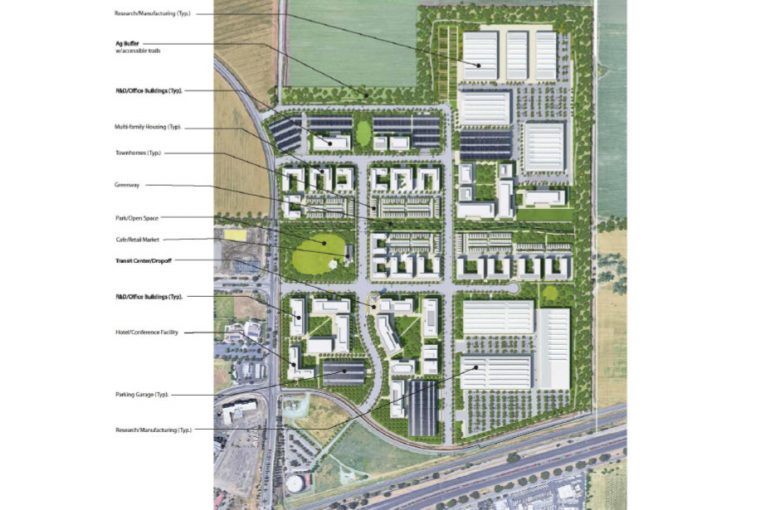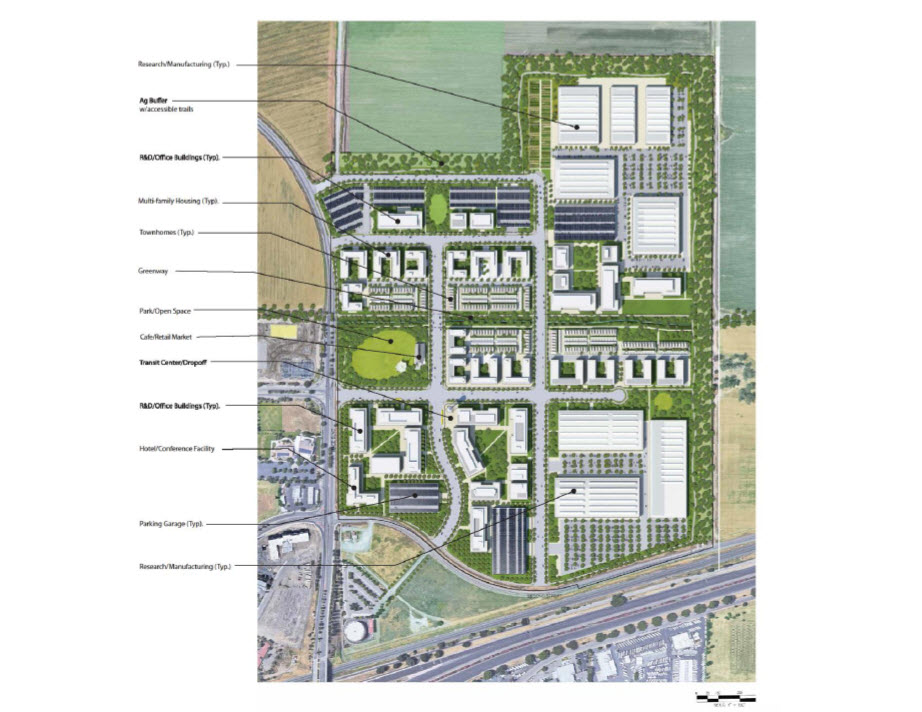

When the Aggie Research Campus is built out, it will include up to 2.654 million square feet of innovation center uses, along with 850 residential units of “varied sizes and affordability.” The affordable housing plan will go to the Social Services Commission on Monday evening.
Staff writes: “Although the developer has a gross total number of housing units (850), general unit types, and density range for which they are seeking approval and they do not know the specific numbers of each housing type that will ultimately be built. Therefore, it would be speculative to conclude that any particular combination of affordable units would be required.”
Staff notes that the 850 housing units being requested will “likely be comprised of a blend of multifamily rental and for-sale single family.”
The anticipation is that the single-family for-sale units would be “attached medium-density housing types which are typically offered at a more affordable price point for the market rate housing than detached low-density residential homes.”
The multi-family units will be “designed for ARC employees and are anticipated to be predominantly 1-bedroom and studios.”
Staff adds: “Future residential project proposals at ARC will be required to apply to the City for entitlements. Housing will be constructed in phases over the course of several years concurrent with the development of commercial.”
Staff further writes: “To account for the variability in timing and precise unit types, the applicant’s plan puts the requirement for determining what type, where and when each affordable unit will be provided on the future residential builders within the Project.
“Under the plan, compliance may be achieved cumulatively or on a project-by-project basis. As each phase of residential construction occurs, the builder then seeking entitlements will have to show compliance with the affordable housing plan and its alternatives consistent with the options provided for under the existing Affordable Housing Ordinance.
“It should be noted that the applicant proposes to comply with the Affordable Housing Ordinance as it is adopted today. Should the city make modifications to the existing provisions, those would not apply to the Aggie Research Campus,” staff adds.
“Considering the project will be built-out over the course of many years, the applicant desires certainty relative to the affordable housing requirements and provisions,” staff concludes. “In this way, the city will also be guaranteed a level of affordable housing that is consistent with the existing Affordable Housing Ordinance. The Project’s Affordable Housing commitments will be a  baseline project condition that would not be subject to amendment without going back to the voters.”
baseline project condition that would not be subject to amendment without going back to the voters.”
The developer in their proposal notes: “It is anticipated that the ARC housing will be approximately one-third single-family attached ownership housing units, and two-thirds multi-family rental housing units (280 single-family and 570 multi-family units).”
However, the agreement at this time is not binding the developer to this assignment of units. “Rather, the precise mix of units will be determined at a future date(s) by one or more home builders based upon builder preference and market demand.”
The controlling factors on housing are that the median overall housing density will be no less than 30 units per acre with the density range of 15 to 50 units per acre and “the housing shall be consistent with any mandatory description contained in the Project’s baseline project features as approved by the Davis electorate.”
The precise mix has yet to be determined. They note once again the units, “due to Project phasing, are likely to be built out over the course of several years by different home builders, the ARC affordable housing plan seeks to memorialize the affordable housing obligations that will pertain to all housing development(s) at any and all phases of ARC.”
Pursuant to this arrangement, the developer and its successors-in-interest may elect to fulfill ARC affordable housing obligations through, but not limited to, any of the following methods:
- On-site construction of affordable ownership or rental units;
- Acquisition and recordation of permanent affordability restrictions on existing housing units within the City;
- Provision of a land dedication site;
- Payment of in-lieu fees;
- On-site construction of accessory dwelling units;
- Project individualized program; and/or
- Alternative manner such as a pledge to the City of a continuing revenue source for achieving affordable housing goals.
They add: “The precise method for fulfilling all or a portion of the affordable housing obligation shall be submitted concurrent or prior to a submission for entitlements authorizing the development of housing at ARC.”
—David M. Greenwald reporting







This article took 750 words and tells the readers almost nothing. Let me save them some time with this summary in 65 words.
1) There will be 850 housing units. ARC will tell us how many single family sales and rental units there will be when their builders tell them what they want to build.
2) ARC doesn’t know what the affordable housing plan it will but it will be good and will be in compliance with the City’s current ordinance whether or not that ordinance strengthens in the future.
What a waste of the Social Services Commission’s time. But at least the City and ARC can check the box that this proposal went to them.
I actually think the following wording from the article is more enlightening/clear, compared to the portion of Alan P.’s comment quoted above:
But the rest of Alan P.’s comment is spot-on.
So the city could eliminate affordable housing provisions and it would not apply ARC, which would still have to comply to the old provisions.
Regardless of what one thinks of Affordable housing, the city is responsible for addressing SACOG’s RHNA requirements.
Hopefully, within city limits (in reference to the University Mall/Commons proposal, for example).
This is not an “Affordable Housing Proposal,” as the headline states. It is the avoidance of an affordable housing proposal.
It’s very clear what the ARC developers are trying to do: avoid providing affordable housing
The City is scheduled to finally update its “interim” affordable housing ordinance in 2020 after months of inaction on its previous deadline. ARC is trying to lock in the reduced requirements of the interim ordinance before the project actually makes it onto the ballot next year .
The Project’s Affordable Housing commitments will be a baseline project condition that would not be subject to amendment without going back to the voters.
Woah, haven’t even some Council members called the 5/5/5 affordable plan a sort of placeholder, likely below what is actually required? And ARC would not have to exceed this over a several decade build-out?
Based on what I know about ethics and physics, the so-called developers will probably evaporate once the meeting is called to order — sorry, this is so crazy, that I can’t write something that makes sense. I have failed all of you.
Todd E: yes, the developers want to lock in the City’s temporary weak affordable housing provisions for the project buildout time period, which is as long as 50 years according to the Vanguard.
But it’s worse than you think the single-family attached ownership units only require 10% affordable to low-income under the interim ordinance. And if they are stacked condominiums or ownership units within vertical mixed-use development, the requirement is only 5%.
Rental units part of a “vertical mixed use” structure woohoo also only require 5% affordable .
I find Rik’s position here really puzzling. He acts as though he is so concerned about affordable housing. The reality is that he’s opposed to this project. He will be opposed to this project regardless of the amount of affordable housing it has. So will Ron O. If they get their way, the amount of affordable housing that will be built here is zero. That’s reality. But somehow Rik is trying to trick himself into believing that he’s an affordable housing supporter – he’s not. His preferred alternative is zero housing here and thus zero affordable housing.
That was supposed to be formatted differently, but my editing period ended prematurely and abruptly, like the life of the victim of the hybrid owl-tomato of justice, the patron saint of Yolo County.